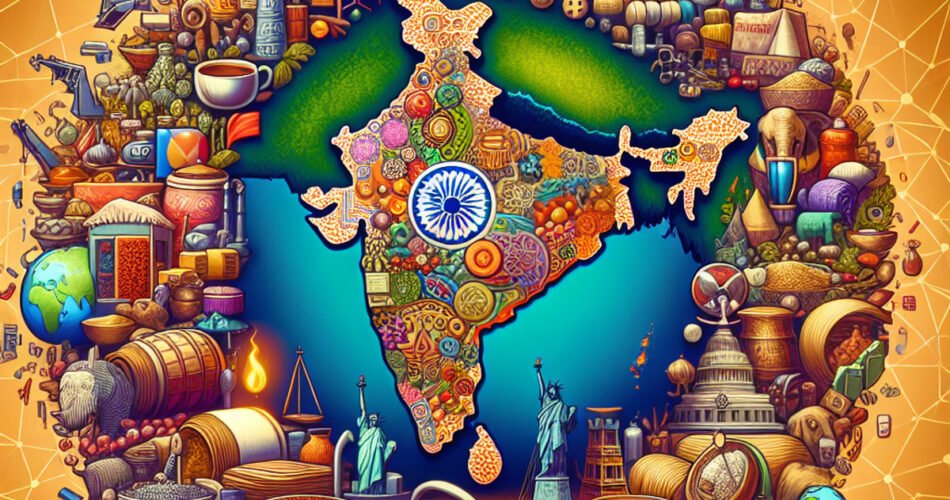Foreign Trade
India’s foreign trade encompasses the import and export of goods and services between India and other countries. This exchange plays a crucial role in the Indian economy. Goods exported from India are shipped to various nations, while imported goods fulfill domestic demands. Understanding India’s foreign trade involves analyzing its major exports, imports, and trading partners.
Read More: Financial Sector in India: Structure, Role, and Reforms
Main Features of India’s Foreign Trade
These are the main features of India’s foreign trade after Independence:
- 1) Increasing Share of Gross National Income: Foreign trade plays a significant role in India’s national income. In 1950-51, foreign trade (imports and exports) accounted for 12% of the national income. By 2019-20, this had increased to 31% of the net national income.
- 2) Less Share in World Trade: India’s share in global trade remains relatively low. In 1950-51, India’s share in world import trade was 2%, and in export trade, it was 1.8%. By 2019-20, these figures had only slightly increased to 2.3% for imports and 2.1% for exports.
Read More: Understanding the Critical Role of Service Sector in Indian Economy - 3) Oceanic Trade: A significant portion of India’s trade is conducted via sea routes. India has minimal trade relations with neighboring countries like Nepal, Afghanistan, Myanmar, and Sri Lanka. Consequently, 68% of India’s total foreign trade and 95% of the total quantity are carried out through sea routes.
- 4) Increase in Volume and Value of Foreign Trade: Since independence, both the volume and value of India’s foreign trade have seen substantial growth. In 1948-49, the total foreign trade was ₹792 crores. By 2019-20, this had surged to ₹55,80,808 crores, with exports worth ₹22,19,854 crores and imports worth ₹33,60,954 crores.
- 5) Change in the Composition of Exports: There has been a notable shift in the composition of India’s exports since independence. Initially, India exported mainly agricultural commodities such as jute, cotton, tea, oilseeds, leather, cereals, and cashew nuts. Now, India exports a significant amount of finished goods, including machinery, ready-made garments, diamonds, jewelry, electronics, and cashew nuts. Additionally, the export of services has increased considerably.
- 6) Change in the Composition of Imports: The composition of India’s imports has also evolved. Before independence, India primarily imported consumer goods like medicines, clothes, motor vehicles, and electrical goods. Today, India imports a larger volume of petroleum products, machinery, gold, chemicals, fertilizers, oilseeds, raw materials, and steel.
- 7) Direction of Foreign Trade: The direction of India’s foreign trade has undergone major changes. Before the Second World War, in 1938, a significant portion of India’s trade was with England, accounting for 34% of export trade and 31% of import trade. Post-independence, these numbers have declined sharply. In 2019-20, England’s share in India’s export trade was 2.8%, and in imports, it was 1.4%. The share of developing countries in India’s exports was 43.6%, and in imports, it was 43.2%. The importance of OPEC countries like Iran, Iraq, and Saudi Arabia has increased, while trade with Eastern European countries like Russia has decreased.
- 8) Balance of Trade: Before independence, India’s trade balance was favorable. However, post-independence, the trade balance turned unfavorable, with imports surpassing exports. In 1944-45, the trade balance was in India’s favor by ₹42 crores. By 1946, the balance became unfavorable. In 2019-20, the trade balance deficit was ₹11,41,100 crore. During the planning periods, India’s trade balance was favorable only in 1972-73 and 1976-77.
Read More: Boosting Growth: The Role of Foreign Capital in the Indian Economy - 9) State Control over Foreign Trade: The Government of India exercises significant control over foreign trade. The primary objective of the government’s foreign trade policy (2015-20) is to promote exports. There are numerous restrictions on importing unnecessary goods. The government has established several institutions to boost exports, such as the Board of Trade, Export Development Committees, Export Inspection Advisory Councils, Export Credit and Guarantee Corporation, and the Directorate of Exhibition.
- 10) Foreign Trade by Government: The government has established various corporations to manage foreign trade. For instance, the State Trading Corporation, established in 1956, provides necessary support for the export and import of small-scale industries and the handicraft sector. The Mineral and Metals Trading Corporation (MMTC), established in 1963, exports minerals and metals and is India’s largest trading company.
Read More: Understanding the Public Sector Function
Conclusion
In conclusion, understanding India’s foreign trade is crucial for grasping its economic impact. Since independence, India’s trade has grown significantly, increasing its share in national income and evolving in the composition of exports and imports. Despite a modest global trade share, India’s foreign trade is vital for economic growth, relying heavily on oceanic routes and state control. Analyzing these features offers valuable insights into the dynamics and future prospects of India’s international trade.
FAQ on India’s Foreign Trade
What are India’s main exports and imports?
This article provides a foundation for understanding India’s foreign trade, but doesn’t delve into specifics. However, it mentions a shift in the composition of exports and imports. To learn more, you can explore further resources to discover India’s top exports (e.g., refined petroleum, pharmaceuticals, textiles) and imports (e.g., machinery, electronics, gold).
How has India’s foreign trade evolved since independence?
The article highlights the significant changes in India’s foreign trade since independence. This includes an increase in its share of the national economy (Gross National Income) and changes in trading partners and goods exchanged. Further research can reveal details like trade liberalization policies and their impact.
What role does foreign trade play in India’s economic growth?
The article emphasizes the vital role of foreign trade in India’s economic growth. Analyzing trade patterns and government policies (like state control) can provide deeper insights into this relationship. You can explore how exports generate foreign currency and contribute to job creation.

